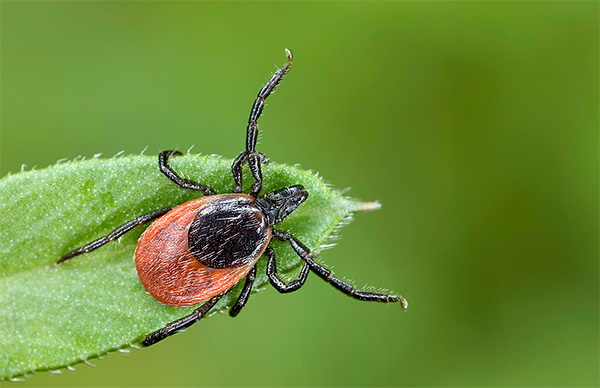
Ixodid ticks (Ixodidae) are highly specialized parasites of vertebrate animals, including mammals, birds, and even some amphibians. The mite life cycle consists of 4 morphological phases, two of which are separated by molts.
The first phase is passive, and takes place during embryonic development in the egg stage. Three subsequent stages are associated with the activity of the parasite - this is the phase of the larvae, nymphs and adults (adult). And although most ticks live outside the host’s body in the external environment, blood sucking is the most important condition for the parasite’s transition to the next stage of the life cycle.
Below is a diagram of the life cycle of the Ixodes tick:

On a note
At a certain stage of development, causative agents of infectious diseases can sometimes enter the body of the tick, sometimes representing a mortal danger to humans and animals. Just below this point will be considered in more detail.
Features of reproduction and development of ticks
Female ticks are prone to persistent gonotrophic harmony. That is, after each blood saturation in the body of the female, irreversible transformations begin, associated with the preparation for childbirth.
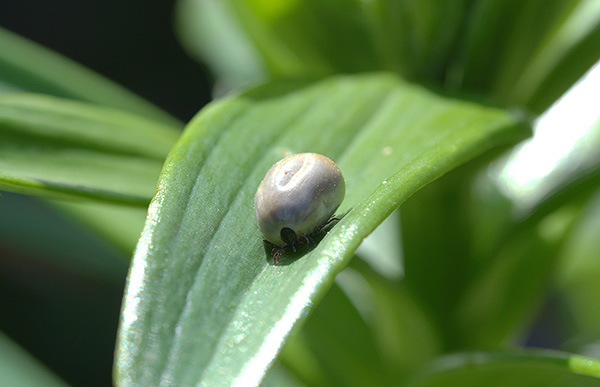
It is interesting
Successful completion of the gonotrophic cycle is possible only in well-fed females, and full blood saturation is possible only in inseminated females.
The life cycle of a tick is formed from a strictly organized set of physiological sequences. The female tends to a single biological goal - to lay eggs. To do this, it needs to mate with a male and as fully as possible to saturate with blood during parasitism on a suitable host.
In natural populations, the proportion of inseminated females is no more than 50–65% of the total number of active female sexually mature individuals.
Under favorable climatic conditions in the mating season, the number of inseminated females increases. A high population density also contributes to an increase in the number of inseminated individuals.
Both inseminated and non-inseminated females, as well as males, attack animals. It is not uncommon when mating occurs in places of suction to the host body.
Males of most species of ixodid ticks die after one or two matings. Virgin males under favorable conditions continue to live up to a year or more.
In the process of mating, which lasts from several hours to several days, the female parasite is not limited in mobility - she continues to hunt and feed. Males attach to the female with the help of two pairs of limbs, thereby severely limiting themselves, and cannot parasitize during mating.
On a note
Females and males of Ixodes ticks find each other thanks to special chemicals - pheromones. The greatest pheromone activity in the female is observed at the time of blood saturation. Males catch the smell of pheromones at a great distance and unmistakably find females even under adverse weather conditions.
The drunk fertilized female increases in size several times. After saturation, it disappears from the host, and the biological mechanism of preparation for egg-laying is launched in her body. Depending on the time of year and the ambient temperature, the laying process takes from two weeks to three months.
The photos below show the female Ixodes tick during egg laying:
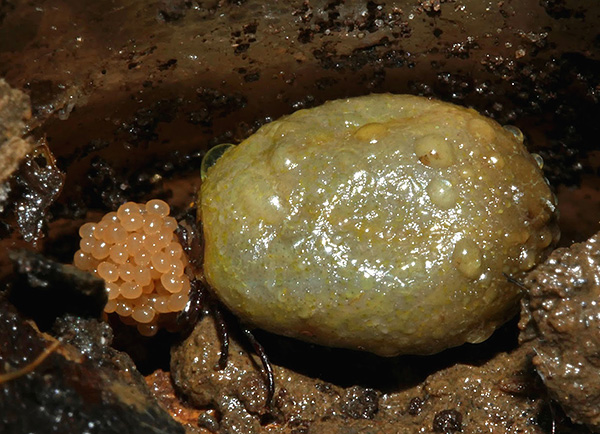
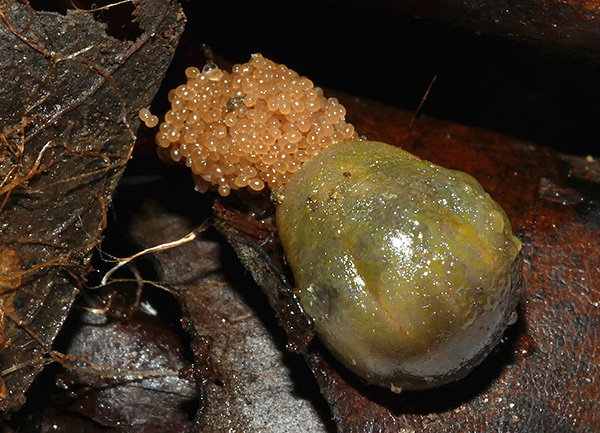
When the fed females enter the diapause, the onset of egg-laying is delayed until the next activity.
It is interesting
The females of ixodic ticks hold the absolute record in fecundity among all bloodsucking arthropods. The maximum saturated individual is able to lay up to 20 thousand eggs.
Mites lay their eggs in the upper layer of the litter to a depth of no more than 3-5 cm. After the laying of the egg, the females survive for several days. After this period, they die as a result of changes in the digestive system and the irreversible breakdown of the internal organs.
Embryonic development of the parasite
A few days after laying inside each egg begins the rapid process of cell division and the formation of the future organism. At the very beginning of embryonic development, embryonic discs form inside the eggs, which in turn become the basis of the future parasite. In the life cycle of the Ixodes tick, this is the only non-parasitic stage of development.

On a note
Females can transmit pathogens of dangerous diseases to their offspring even at the stage of egg formation inside their own organism. Even non-hatching eggs carry potential danger to humans and animals.
For example, goats feeding on bark and branches of shrubs may become carriers of tick-borne encephalitis pathogens after ingesting the root parts of plants with egg-laying fragments.
The duration of embryonic development of Ixodes ticks largely depends on external climatic factors:
- average daily ambient temperature;
- relative air humidity;
- day lengths
In some cases, the process of formation of future parasites at this stage of the life cycle may slow down and stretch over several months.
A distinctive feature of late egg-laying is that the mechanism of intensive cell division is not activated inside the germinal discs, and the eggs go into wintering. In this case, the hatching of the larvae occurs only the next season, after the onset of stable positive average daily air temperature and sufficient warming up of the forest floor.
In the final stages of development, the embryo is formed into a larva similar to an adult individual, but with three pairs of limbs (in an adult individual there are 4).
Stages of postembryonic development of ixodic ticks
In the first days of life after hatching, young parasites do not show aggression and spend all the time in the shelter, because during this period the final stage of the formation of protective covers and the release of the first waste products from the viscera occurs.
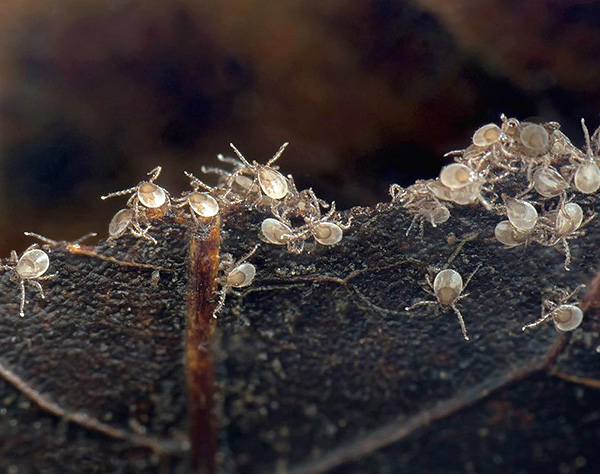
It is interesting
At this stage of development (that is, immediately after hatching from eggs), the complex of behavioral reactions to the appearance of the host does not manifest itself in the larvae of ixodid ticks for several days. During this period, the parasites are in the process of development, and in most cases they do not stick to the victim, even with direct contact.
Upon completion of the process of development and complete metamorphosis, young larvae begin to actively look for hosts for feeding. Most often, small burrowing mammals or nesting birds become victims of ixodid tick larvae. Larvae penetrate their homes and stick to fixed animals during sleep or rest.
The larvae feed on blood once - usually within a few hours (in rare cases, a few days). After saturation, young parasites fall away from the host and begin to prepare for molting - this process takes from several weeks to several months, depending on the climatic factors.
During the molt, the larvae transform, shed the outer cover (cuticle) and grow the fourth pair of limbs.
Upon completion of the transformation, the tick enters the nymphal phase of its life cycle. Nymphs in form and structure are very similar to adults, but do not have full-fledged genitals, therefore they are not capable of reproduction.
The main biological tasks of the nymphal stage of development in ixodic ticks:
- Weight gain;
- Formation of the germs of the reproductive system;
- The formation of the rudiments of more developed limbs and a new cuticle.
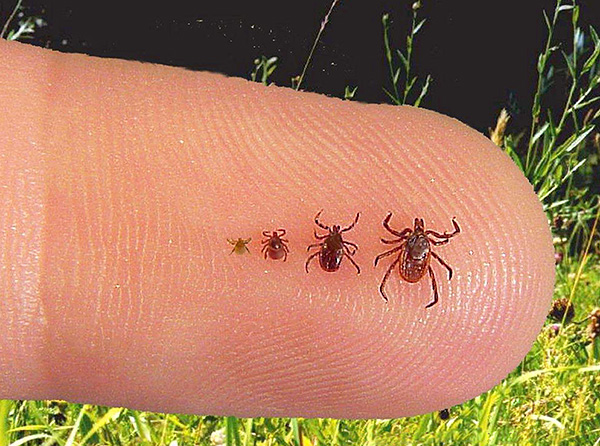
The parasitic stage of nymphs lasts a little more than a day. Small animals (hares, hedgehogs, foxes, squirrels) or small cattle are usually the hosts for the parasite during this period.
At saturation, the nymph of the tick leaves the victim, after which the molting mechanism is activated.This process can take quite a long period of time, and in some cases at this stage it is possible to leave for the winter.
The determining factors in the rate of molting are temperature and humidity, as well as the length of the day.
At the end of the molting process, the parasites undergo significant internal transformations and turn into adult individuals (adults).
The entire period of postembryonic development takes from one to three years, depending on the natural zone and the climatic conditions of the area.
Danger of parasite intermediate forms for humans and animals
The parasitic tick-feeding system does not pose a serious danger to humans unless it includes third-party biological components (viruses, bacteria).
Unfortunately, ticks often become carriers of microorganisms dangerous for humans and animals that can cause lethal infectious diseases.
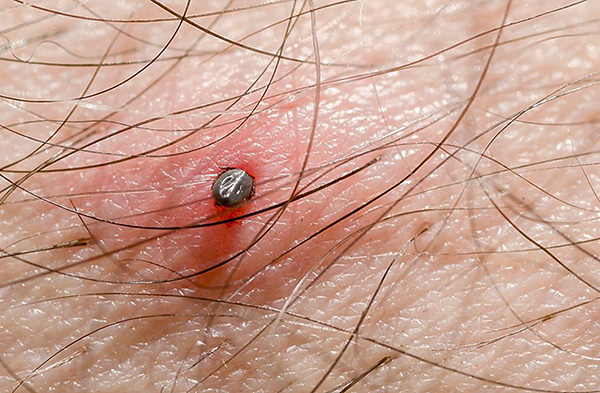
On a note
The most dangerous for humans are tick-borne encephalitis and borreliosis pathogens. These infectious diseases affect the human nervous system (and not only it), and sometimes lead to irreversible consequences, including disability and death.
The greatest danger to large warm-blooded animals and humans is ticks at the final stage of their life cycle (imago). The intermediate stages of ixodides are usually content with small animals, which are waiting in burrows or nests.
There is also the possibility of infecting a person with dangerous tick-borne infections without sucking the tick directly. This method of infection is called alimentary. Most often this occurs when eating raw dairy products derived from domestic animals, into the body of which penetrated infectious agents.
The spread of tick-borne infections in natural biotopes is focal. The main supporting factor for the spread of pathogens of borreliosis and encephalitis are resistant populations of small rodents. Voles, shrews and other small warm-blooded animals transmit pathogens to all feeding stages of ticks, and they, in turn, transmit infection to other small rodents.

Thus, the stability of the natural focus of pathogens of encephalitis and borreliosis persists for decades.
In such ecosystems, the risk of becoming a victim of a tick, which is a carrier of pathogenic microorganisms, increases tenfold.
The life span of the parasite and periods of the highest danger to humans
The development of a tick at all stages of its life cycle directly depends on favorable weather conditions, as well as on the availability of food supply. For each phase of development of the parasite a time period of at least one year is required. The total lifespan of ixodides is 3-4 years.
The duration of each phase of development is greatly influenced by the successful saturation of the parasite. The sooner the tick finds its owner and is filled, the faster it will molt and move on to the next stage (and the shorter will be its life in general).
For adults, behavioral diapause is characteristic. Therefore, the highest danger to humans and animals imagos are in spring and autumn.

For the nymphal stage, behavioral diapause is optional, so this life form is dangerous throughout the year, with the exception of the winter diapause.
As a rule, the larvae do not pose a direct threat to humans, since they do not have a sufficiently developed oral apparatus and limbs for successful hunting for large mammals.
On a note
Pasture animals can asymptomatically tolerate dangerous diseases caused by tick bites. At the same time, viruses that are in their organisms can be transmitted to humans - for example, when they use milk or cheese.
Goats and sheep can swallow infected tick larvae in the basal layers of vegetation. As a result, a warm-blooded animal becomes a natural reservoir for dangerous microorganisms. Thus, even the larval non-parasitic stage can be dangerous to humans.
Interesting video: how ticks lay eggs after a bite
About the development cycle of ticks and their habitat



